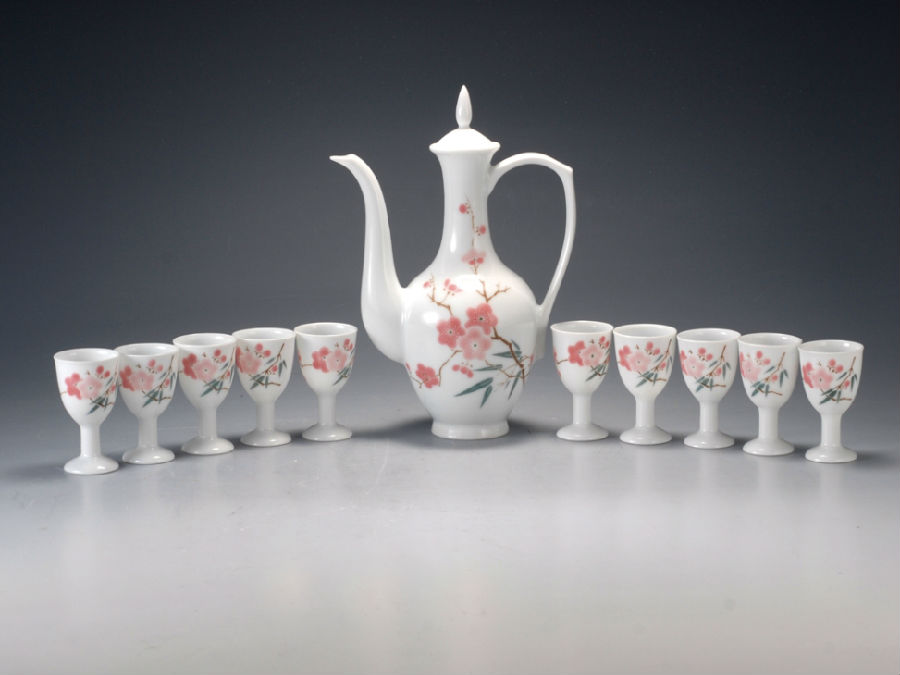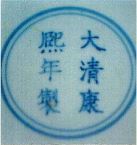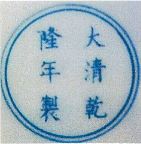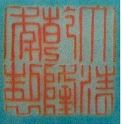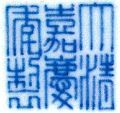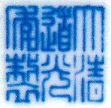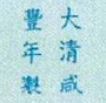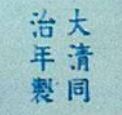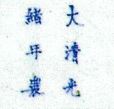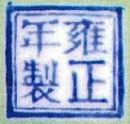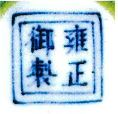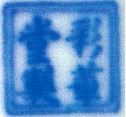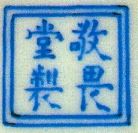The history of Jingdezhen
Referred to as China's "porcelain capital," Jingdezhen has long been known as a place for porcelain production. Due to its location south of the Changjiang River that presently runs through Jiangxi, it was also called Changnanzhen.
At the time of the Northern Song dynasty's Jingde period (1004-1007), Emperor Zhenzong was enchanted by the translucent beauty of white porcelain; he had written at the bottom of the pieces the phrase "made in the Jingde period" and changed the name of Changnanzhen to "Jingdezhen," Jingdezhen has a long history of porcelain production; it began in the 1st century AD at the time of the Later Han Dynasty, and by the time of the Chen dynasty (of the Northern and Southern Dynasties), production was already booming.
The Song Dynasty was a time of utmost popularity for Jingdezhen's porcelain production. The area's celadon and white porcelain were exceptional in their artistry and historic value; Jingdezhen had carved out its place in history as a famous site of porcelain production. Furthermore, at this time production techniques for Yǐngqīng (shadow green glaze) also being developed, which would have a tremendous impact on future generations.
During the Yuan dynasty, porcelain production techniques advanced even further, and the first half of the 14th century AD saw the birth of blue and white porcelain in the kilns of Jingdezhen. Blue and white porcelain is a form of decorated pottery on which a cobalt painting is applied underneath a white porcelain glaze, followed by a layer of transparent glaze, and is fired at a high temperature. It has extremely high historic value. In 2005, a blue and white porcelain piece called "Guigu xiashan" was auctioned off in the United Kingdom for 230 million yuan (approx. 3 billion yen). Among the first generation of blue and white porcelain pieces are many monumental works, and many pieces with fine detailing were exported to the Islamic world. In addition, at this time other forms - such as "lapis lazuli glazed porcelain," in which cobalt was applied to the entire surface, and "crimson glazed porcelain," in which copper-red glaze was applied to the entire surface - were also made.
At one time, Jingdezhen had a governmental porcelain kiln as well as a private kiln. Throughout the Yuan, Ming, and Qing dynasties, a kiln specifically for purveyors of the imperial court - in other words, a governmental kiln - was built, wherein many porcelain pieces for the personal use of the emperor and other Imperial Court members were made. For the general market, there was a private kiln (a kiln for firing porcelain for the use of the masses, inheriting past techniques and traditions); the porcelain pieces fired in these kilns were not just for the domestic market in China, but were also exported to many other countries throughout the world. In order for production to keep up with increasing demand, a system which combined the governmental and private kilns was put into place. As a result of this, superior porcelain raw materials and crafting techniques made their way into the private kilns and greatly advanced. The Ming and Qing dynasties brought about a thriving porcelain industry, and Jingdezhen established its position in the world of Chinese ceramics and porcelain.
The history and porcelain in China from the Qing Dynasty to the present
The Qing Dynasty (1644-1911) was the last dynasty in China and its rule lasted around 270 years. While the dynasty itself was ruled by the Manchus, its cultural policies respected the traditional culture of the Han Chinese and thus did not destroy their culture. This meant that they respected porcelain works and the porcelains of this era is still preserved as one of the world's greatest works.
This Qing Dynasty began when the third emperor 順治帝 Shunzhi rose from current Shenyang City in Liaoning province to in reality defeat the Ming Dynasty. He changed the year to the Shunzhi era and the capital to Beijing and increased his territory and created an aristocratic system. The nation state was established around a central government and the idea of "enrich the Country, Strengthen the armed Forces". it was a rare time in the Chinese history to be led by good rulers successively and they had good policies which differs greatly from the previous Ming Dynasty.
While emperor Shunzhi struggled for decades after being crowned emperor to tackle uprising from former Ministers from the Ming Dynasty and the southern region, he gained control over the Jiangxi province including 景徳鎮 Jingdezhen in 1645, and appointed 李翔鳳 Li Xiangfeng as the provincial governor and worked hard to restoration of Jingdezhen, had porcelain be given as offering from 1651, and by year eleven it became an official Royal Factory (a kiln where expensive porcelains under the order of the government are made) under the Qing Dynasty.
However, most of the Potters were old and worked from the Ming and Wanli periods, Tianqi, and Chongzhen periods and their apprentices. So, the works were not so different from the end of the Ming era, and the costs were so minuscule that it was covered by the local governmental fee every year. 20 years later, under 康熙帝 Kangxi emperor, the Royal Factories were reconstructed and popularized porcelain making and led to the birth of Qing Guan ware masterpieces.
The 4th emperor Kangxi was a truly great ruler and resided over 61 years. During his rule, he appointed 朗廷極 Langham as a ceramic officer, and set the future direction of the Qing Guan ware, and he was both the Jiangxi provincial governor and ceramic officer for 7 years between 1705 and 1712
and created the masterpiece called the Lang Kiln. This dark red porcelain is called Lang Kiln red, cow blood red, and red jewels in Chinese, and cinnabar in Japanese, and it is famous to this day.
From the French king Louis to the aristocrats from Britain, Netherlands, and Germany, they all invested heavily, and it is apparent that they collected the masterpieces in the Kangxi era through the east india Company from based on written accounts, and much of the works are told on as master pieces to this day.
When Kangxi emperor died after 61 years in power (1662~1722), the fourth emperor 雍正帝 Yongzheng took over. He was a prince for a long time, so his reign only lasted 13 years (1723~1735) but he was passionate towards art and in 1727, he appointed 年希尭 Niyang Xi Yao as chief customs inspector at Huai’an and a ceramic officer of the Royal Factories. The following year he appointed Tang Ying as the supporter and attempted to improve the quality of the Guan ware.
Tang Ying erected a famous stone monument called “事宜紀略 Shiyi ji lue” in the winter of 1734, it has detailed descriptions on the name of porcelains and it is known as an indicator for future generations.
Tang Ying stayed as a ceramic officer when 乾隆帝 Qianlong emperor took over, and under his leadership he creates古月軒磁器 Gu Yue Xuan Porcelain.
The 6th emperor Qianlong was crowned at 25 years of age, and he modelled his policies to that of his grandfather, Kangxi emperor. Thus, he was known for his wise leadership and his reign lasted 60 years (1736-1795), resulting in a truly peaceful era. as his grandfather, Kangxi emperor ruled for 61 years, he abdicated after 60 years in power and passed the crown to his son, 嘉慶帝 Jiaqing emperor, and he himself became emperor emeritus and passed away at 88 years of age.
additionally, at this time, trade with western countries accelerated and China gained great wealth from exporting large amounts of silk and porcelains. as a result, the economy flourished and especially in relations to porcelains, techniques developed in the Kangxi and Yongzheng eras, and became the golden age of unparalleled elaborate porcelains.
Following the Qianlong era, Jiaqing emperor’s rule lasted 25 years (1796~1820), and at Jingdezhen its techniques and colors did not change so much due to the effect of the Qianlong era, and the Jiaqing Guan wares were maintained.
During the last years of the Jiaqing era, the country started to weaken. on top of that, external pressure from Britain’s invasion to the east increased financial pressure on the Royal Factory and the decline in quality in the porcelains are apparent. For instance, the clay used is rough and the base of the white glaze is forming small creases, and the techniques of the five colors and powder pigment declines. There is an increase in porcelains that are made to cater to Western tastes and made specifically to export.
The next 道光帝 Daoguang emperor ruled for 30 years (1821~1850) and he enjoyed literature and encouraged arts and crafts there was a slight revival of the porcelain industry. However, in 1840 the start of the opium War led to the invasion of countries such as Britain, opening of the ports in Guangdong, Fuzhou, and Xiamen, and Hong Kong to be ceded. Nonetheless, activities in Jingdezhen continued to the same degree since the former era and left wonderful porcelains such as 慎徳堂 Shen Yutang.
also, in this era, there were many copies of the porcelain works of the Ming 宣徳 Xuande era and 成化 Chenghua era arabesque pattern dyed porcelains, and most of the surviving copy works were from this time.
in the 咸豊帝 Xianfeng and 同冶帝 Tongzhi era (1851~1874), there was the Taiping Rebellion in 1851, was forced to sign the humiliating the Treaty of Tianjin after losing to the combined forces of the British and the French in 1858, and Beijing was invaded in 1871 leading to the burning down of the emperor’s palace, the old summer palace, and around 200 architectures resulting in countless artefact being looted. even the Royal Factory in Jingdezhen was destroyed by 洪秀全 Hong Xiuquan of the long queue clan, and it was forced to temporary stop all activities, but around half of it was restored by 李鴻章 Li Hongzhang who promoted the restoration of the Qing Dynasty and modernisation.
in the era between Tongzhi and Guangxu (1875~1908) the mother of Tongzhi, 西太后 empress Dowager Cixi took control as 光緒帝 Guangxu emperor was too young to rule. in 1894 there was the Sino-Japanese war and in 1900 Beijing was occupied and looted by the eight-Nation alliance force. Not only was the nation’s pride in tatters, but the state was financially bankrupt, and it was not the time for operating Guan wares. However, empress Dowager Cixi ordered potteries for the royal family and this led to increased activity for the Guan wares and this is where porcelain master pieces with the empress Dowager Cixi’s penname 大雅斉 Daya Qi inscribed onto it.
at this time, the potters who inherited the old traditional techniques who were working in the Royal Factory, went to private factories to support themselves and worked more there. There has been special focus on exports, and many were sent to Japan, but the unique aspect of this era is the sheer number of old antiques created.
The last era of the Qing Dynasty, the 宣統 Puyi era was very short and ended in three years, and the Republic of China was established. under the rule of the second President 袁世凱 Yuan Shikai, a small amount of potteries such as those with 居仁堂 Ju Rentang and 洪憲 Hong Xian era potteries were created. in the era of the Republic of China, Royal Factories were abolished, and a fraction of the porcelain industry became independent as private factories and continued its production at a limited quantity.
With the establishment of the People’s Republic of China (1949), the Royal Factory in Jingdezhen was reconstructed with the aim of creating Qing Guan wares by adopting the operation system by the Republic with the development of the systematization of the nation. Simultaneously, mass production for the general public was conducted and efforts were put to cater to export.
Qing period emperor porcelain marks
Porcelain ordered by the emperor was fired at Jingdezhen, and a crest with the emperor's name was written in kanji or seal engraved on the blue and white porcelain.
(大 Great 清 Qing dynasty 康熙 emperor Kangxi 年Year 製 Made)
大清康熙年製 da qing Kangxi nian zhi (1662-1722)
大清雍正年製 da qing Yongzheng nian zhi (1723-1735)
大清乾隆年製 da qing Qianlong nian zhi (1736-1795)
大清嘉慶年製 da qing Jiaqing nian zhi (1796-1820)
大清道光年製 da qing Daoguang nian zhi (1820-1850)
大清咸豊年製 da qing Xianfeng nian zhi (1851-1861)
大清同治年製 da qing Tongzhi nian zhi (1862-1874)
大清光緒年製 da qing Guangxu nian zhi (1875-1908)
大清宣統年製 da qing Xuantong nian zhi (1909-1912)
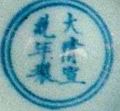
Chinese famile rose porcelain
Famille rose is a porcelain painting technique that began in China during Emperor Kangxi's reign (1662-1722) in the Qing dynasty, and makes use of the cloisonné ware technique that was brought into China alongside other European innovations by Christian missionaries.
The painting techniques used for porcelain before the Kangxi era involved a technique where color was added to a sketched outline. To obtain deeper colors, multiple layers were painted. The pigments used were strong-colored distemper that were baked onto the porcelain at high temperatures.
However, once the cloisonné technique introduced by the missionaries had been utilized for porcelain painting, effects that had been difficult to achieve up till that point including gradations and rich color tone changes could finally be realized.
As it involves painting with pigments mixed into the white, opaque glass powder of enamel, when the porcelain is baked, the glass helps create soft color tones in the paintings. At the beginning, as enamel pigments were imported goods and the combinations were learnt from the Europeans, the colors in Kangxi era tended to be deep and thick.
In the Yongzheng era, successful local production of the enamel pigment began, which allowed much more natural tones to be expressed. As emperor Yongzheng was a big supporter of the arts, he delegated the plan for the production of pigments to Prince Yi, who subsequently produced pigments of 18 colors. Painting was also made smoother, and detailed brushwork for bird and flower paintings was achieved in the painting of porcelain. Furthermore, the Societatis Iesu missionary Giuseppe Castiglione (Chinese name: Lang Shining) who served as a successful Chinese court artist under Emperor Kangxi, Emperor Yongzheng and Emperor Qianlong, blended the European styles, which he helped introduce, with Chinese painting styles, creating unique and beautiful works.
The palace-produced porcelain reflected Emperor Qianlong's tastes, and the colored porcelain's pictures were of high-quality and luxurious decorative designs. With these trends, high-quality painting also began to appear in private studio-produced pottery.
However, at the beginning of the Daoguang, Xianli and Tongzhi era, China's strength was in decline due to the outbreak of the Opium War and the Taiping Rebellion, and as this started affecting official and private porcelain studios in Jingdezhen, the production of pottery largely came to a standstill. As the Qing imperial palace records reflect, for 5 years in Emperor Xianli's reign, Jingdezhen's total pottery output was only 2100 pieces. (In fact, pottery from the Xianli era would become extremely rare). This period did not see a great improvement in quality in the private studio-produced pottery.
The late Qing dynasty saw the appearance of the painter Chengmen (1833-1908), born in Anhui province. He imitated the Yuan dynasty artist Huang Gongwang's ink painting (light purple landscape painting), which was different from the European style paintings of that time period, and was more similar to ink painting, which helped bring about lightly colored painted porcelain. These new display porcelain pieces painted with Chinese styles sold very well, and boosted the revival of Jingdezhen and opened the doors to modern painted pottery.
Guyuexuan
Beijing's "Fa lang Zuo" is one of 28 "Zaoban Chu" (workshops that produced the emperor's furnishings), and enamel paint was made there. Fa lang Zuo was established during the Kangxi, Yongzheng, and Qianlong dynasties when court painters were mobilized for the craft of ceramic paintings, and delicate and beautiful enamel paint called "Guyuexuan" was produced.
at Fa lang Zuo, only white porcelain fired in Jingdezhen was used, and it was painted and fired solely with the enamel paint color.
Kangxi yu zhi | |
Yongzheng nian zhi | Yongzheng yu zhi |
Qianlong nian zhi | Qianlong yu zhi |
 |
unlike other blue and white ceramics that are inscribed with symbols, these articles feature kanji handwritten using enamel.
The names of the head potters involved in porcelain production at the official kilns were never recorded. Chinese ceramics established a division of labor early on, so craftsmen worked in subdivided production processes and did not record their names. even the heads of the Ming dynasty official kilns rarely left their names. However, the names of official kiln supervisors started to be recorded in the Qing dynasty.
唐英 Tang Ying
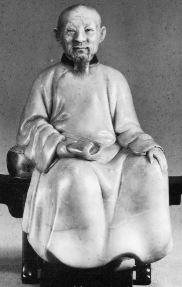 | a man from Fengtian. as a gifted potter related to the Jingdezhen kiln, he was the foremost supervisor in the Qing dynasty who led the same kiln for 20 years, excluding 2 years, from Yongzheng 6 (1728) to Qianlong 21 (1756). Gifted at imitating the enamel of each era, he developed new techniques that drew on oriental methods such as enamel painting, oriental Wujin glaze, oriental violet technique, black background with white flower, white background with gold outline, yo-hen, and others. |
Tang Zhai inscriptions (ceramic studio marks)
Ceramics in the Qing dynasty are marked with Tang Zhai inscriptions such as "中和堂 Zhonghe Tang" and "大雅斎 Dayazhai". "堂 Tang" refers to a reception room and " 斎 Zhai" means school or study room. also, the "軒 Xuan" of "古月軒 Guyue Xuan" can mean scholar or study room.
it is said that the imperial family inscription exists among these Tang Zhai inscriptions, and they are generally regarded as high-quality works of each dynasty. in addition to the imperial inscription, there is the Gugong palace name and individual inscriptions such as bureaucrats and poets, and through research we can determine dynasties in which the inscriptions were used.
順治帝年間 Shun zhi period (1643-1661)
| zi sang xuan zhi 百華齋 | bai hua zhai 梓桑軒製 |
 | 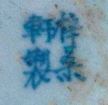 |
康熙帝年間 Kangxi period(1662-1722)
heng feng tang bo gu zhi | jian shi tang | guang hou tang zhen wan zhi |
 | 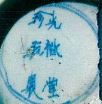 | |
| ------------------------ | ------------------------ | ------------------------ |
bi yu tang zhi | kang xi ren zi zhong tang zhi 康熙壬子中和堂製 | zhao yu tang zhi |
 |  |  |
| ------------------------ | ------------------------ | ------------------------ |
mei yu tang zhi | quan qing tang fang gu zhi | ju xing/xing tang zhi |
 |  |  |
| ------------------------ | ------------------------ | ------------------------ |
shao wen tang zhi | yu ci chun yi tang zhi | jin yu tang zhi |
 | 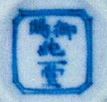 |  |
| ------------------------ | ------------------------ | ------------------------ |
yi de tang zhi | bai yun tang jing zhi | xin yi tang |
 |  | 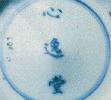 |
| ------------------------ | ------------------------ | ------------------------ |
kang xi gui chou zhong tang zhi | lin yu tang zhi | ju xing tang zhi |
 |  |  |
| ------------------------ | ------------------------ | ------------------------ |
zheng yu tang zhi | mei qing tang zhi | ju yu tang zhi |
 |  | 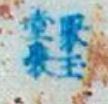 |
| ------------------------ | ------------------------ | ------------------------ |
zhao yu tang zhi | yi yi tang zhi | shen de tang zhi |
 |  |  |
| ------------------------ | ------------------------ | ------------------------ |
yi you tang zhi | yu you tang zhi | mei xu tang zhi |
 | 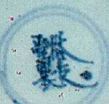 |  |
| ------------------------ | ------------------------ | ------------------------ |
tian bao tang zhi | guang yu tang zhi | ding xing/xing tang zhi |
 | 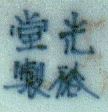 | 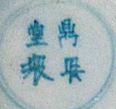 |
| ------------------------ | ------------------------ | ------------------------ |
shi jin tang zhi | de xin tang zhi | yun xiu tang zhi |
 |  |  |
| ------------------------ | ------------------------ | ------------------------ |
zhao shi tang zhi | ci bi tang zhi | pei yu tang zhi |
 |  |  |
| ------------------------ | ------------------------ | ------------------------ |
yong yu tang zhi | guang yu tang zhi | hui yuan tang zhi |
 | 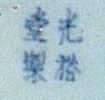 |  |
| ------------------------ | ------------------------ | ------------------------ |
lu yin tang qi | qing yin/yin tang zhi | shou gu zhai |
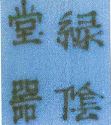 |  | |
| ------------------------ | ------------------------ | ------------------------ |
jin lan zhai zhi | ji ya zhai zhi | zhi lan zhai zhi |
 | 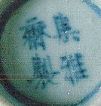 |  |
| ------------------------ | ------------------------ | ------------------------ |
yu ji sui | wen xin zhai | fu xiang xuan yu qing zhi 復香軒玉清製 |
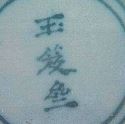 | 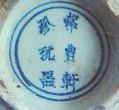 | |
| ------------------------ | ||
| fu xiang xuan yu qing zhi 復香軒玉清製 | ||
 |
雍正帝年間 Yongzheng period (1723-1735)
yang he tang zhi 养和堂製 | dan ning tang zhi | zheng shun tang zhi |
 |  | 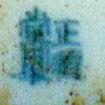 |
| ------------------------ | ------------------------ | ------------------------ |
hao ran tang zhi | dan ran zhai | ji ya zhai zhi |
 |  |  |
| ------------------------ | ------------------------ | ------------------------ |
zhuo cun zhai | da he zhai zhi | de cheng zhai zhi |
 | 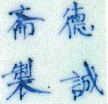 | |
| ------------------------ | ||
jing zhai wan ju | ||
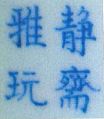 | ||
乾隆帝年間 Qianlong period (1736-1795)
yang he tang zhi | yi shan tang zhi | ya yu tang zhi |
 |  | |
| ------------------------ | ------------------------ | ------------------------ |
xu hua tang zhi | cai hua tang zhi | jing wei tang zhi |
|
|
|
| ------------------------ | ------------------------ | ------------------------ |
dui mu tang zhi | cai run tang zhi | zhi yuan tang zhi |
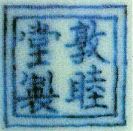 | 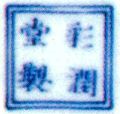 | 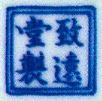 |
| ------------------------ | ------------------------ | ------------------------ |
ban mu tang zhi | cheng xin tang zhi | qi qian cao tang |
 |  |  |
| ------------------------ | ||
cai xiu tang zhi | ||
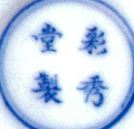 | ||
嘉慶帝年間 Jiaqing period (1796-1820)
cai hua tang zhi | qing yi tang zhi | yu qing tang zhi |
 | 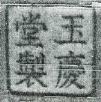 | 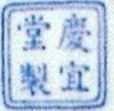 |
道光帝年間 Daoguang period (1820-1850)
xi qing tang zhi | shen de tang zhi | dui ben tang zhi |
 | 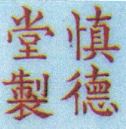 | 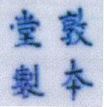 |
| ------------------------ | ------------------------ | ------------------------ |
qiu qian tang zhi | he shan tang zhi | rui di tui si tang zhi |
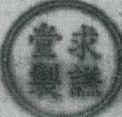 | 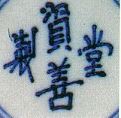 | 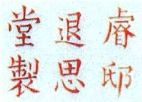 |
| ------------------------ | ------------------------ | ------------------------ |
bao shan tang | ning dao tang zhi | tui si tang zhi |
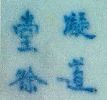 | 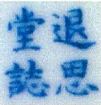 | |
| ------------------------ | ------------------------ | |
ji qing tang zhi | shi yan zhai zhi |
|
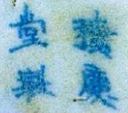 |  | |
光緒年間 Guangxu period (1875~1908)
yan qing tang zhi | da ya zhai |
 | 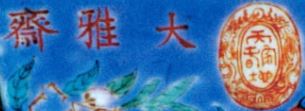 |
※Postscript
“寧晋斎ning jin zhai” goods for imperial household.
”寧遠斎ning yuan zhai” goods for imperial household.
“退思堂Tuisitang” owned by Quezhon, 6th generation grandchild of Duo er shuai.
“思慶堂 Si qing tang” owned by the jinshi Yinghe (jinshi: the status given to those who passed the imperial examination).
“謙牧堂Qian mu tang” owned by the Manchu Kui wen.
“塵定軒Chen ding xuan” owned by the Manchu Ji chang.
“拙存斎Zhuo cun zhai” owned by Shi pu.
“恩補堂en bu tang” owned by Panshi'en.
“雅雨堂Ya yu tang” name of the library belonging to Kangxi era jinshi Jian ceng. Ya yu was its number.
“中和堂製zhong huo tang zhi” owned by emperor Kangxi.
“旭華堂Xu hua tang” name of the library belonging to Kangxi era jinshi Wanghuanceng.
“謙牧堂Qian mu tang” name of the library belonging to the Kangxi era Manchu Kui wen.
“慎徳堂Shen Detang” it is understood that chinaware with the inscription was high-grade chinaware specially ordered by the imperial Prince and other nobility during the Kangxi through Daoguang eras. Shen Detang was the name of the lodging located in one corner of Yuanming Yuan Park, wherein emperor Daoguang spent his final years. it is thought that the pastel chinaware with a red “慎徳堂製Shen Detang Zi” inscription were containers ordered and created for emperor Daoguang to use at his palace.
“朗吟閣製lang yin ge zhi” goods for emperor Yongzheng before enthronemen.
“経筍堂Jing sun tang” name of the library belonging to Yongzheng era jinshi Lei kuang.
“経筍堂Jing sun tang” owned by the Yongzheng era jinshi Lei kuang.
“恭寿堂Gong shou tang” name of the library belonging to Gao sai, sixth child of Taizong, during the Yongzheng reign.
“彩華堂cai hua tang” it is thought that a private kiln of Qian longe emperor.
“楽善堂Le shan tang” name of the temple belonging to imperial prince Yi during the Qianlong era.
“敬思堂Jing si tang” owned by Qianlong era jinshi Liang guozhi.
“来鶴堂Lai he tang” name of the room belonging to Qianlong era jinshi Yu zong ying.
“椿蔭堂Chun yin tang” name of the library belonging to Qianlong era juren (person who passed the imperial regional examination held once every 3 years) Qian li bao.
“思慶堂Si qing tang” name of the library belonging to Qianlong era jinshi Yinghe.
“敬思堂Jing si tang” name of the library belonging to Qianlong era jinshi Liang guozhi.
“忠雅堂Zhongya tang” name of the library belonging to Qianlong era jinshi Jiangshiquan.
“思補堂Si bu tang” name of the library belonging to Qianlong era jinshi Panshi'en.
“塵定軒Chen ding xuan” name of the pavilion belonging to Jiaqing era juren Ji chang.
“有恒堂Youheng tang” owned by imperial Prince Qing during the Jiaqing through Daoguang eras.
“行有恒堂Xing youheng tang” owned by imperial Prince Qing during the Jiaqing through Daoguang eras.
“多福多寿堂Duo fu duo shou tang” owned by the Mongol Chong qi during the Daoguang era.
“大雅斎 Dayazhai” Porcelains painted with the mark are those which were ordered by Xitaihou (empress Dowager 1835-1908) herself, with dayazhai being the name of her living room in the palace. Xitaihou invested large sums in porcelain ware; it is said that these amounted to 128 gram of silver in the Guangxu period alone.
“長春宮” owdered by Xitaihou.
“儲秀宮” owdered by Xitaihou.
”玉海堂” owdered by Xitaihou.
“居仁堂Ju Rentang” it is the inscription found on chinaware made in Jingdezhen, specially ordered by the first president of the Republic of China, Yuan Shikai (1859-1916). The name derives from the name of his palace.
“静遠堂製jing yuan tang zhi“ ordered by president xu shi chang.
珠山八友 zhu shan ba you (eight modern artists of Jingdezhen)
Zhu is another name of Jingdezhen. Ceramic painting artists in the later Qing to the Republic of China period made new art scenes which mixed the traditional Chinese painting technique with the european famille rose style painting which was a major trend by that time.
in 1928, 8 very popular ceramic painting artists made 月園会Yueyuan Society and they passionately pursued modern ceramic painting. Their arts are very popular at the present time and being traded at high prices among ceramic art collectors.
王琦 Wangqi (1884-1937)
王Wan’s pseudonyms were 陶迷道人 Taomidaoren and 江西省新建人 Jiangxishengxinjianren.
When he was 17 years old, he started to learn ceramic art for a living at Jingdezhen. He studied painting technique under the ceramic painting artist 潘陶宇 Pantaoy. Throughout learning, famille rose portrait painting became Wan’s strong point. His work is characterized by its hearty brushwork and his painting style seems to be influenced by 黄慎 Huangshen who was a painter in the Qing era. He is the most praised among the eight persons of Jingdezhen. His studio was known as 陶陶齋 Taotaozhai.

王大凡 Wangdafan (1888-1961)
王Wang began his career in Jingdezhen as a young man, and, over the course of roughly a half century, worked as a porcelain painter. He was a skilled painter of figure portraiture, landscapes, and nature scenes, and the originator of 落地粉彩 the landing pastel technique(paint with the color glass powder directly to the porcelain surface without white glass powder base)). in the early years of the Republic, he established the Jingdezhen Ceramics institute with 王琦Wangqi and others and held regular exhibitions. He also published many specialty newspapers and magazines, such as the Jingdezhen Craft Daily.
in 1915, the large porcelain portrait vase "富貴寿考fuguishoukao", which featured his painting, was chosen for first prize at the Panama–Pacific international exposition. His painting style is simple, and his brush work is delicate. at times, he offers up a peculiar style. in the era of the People's Republic of China, he served as the executive director of the Jingdezhen Porcelain artists association and the Jiangxi Provincial artists association.
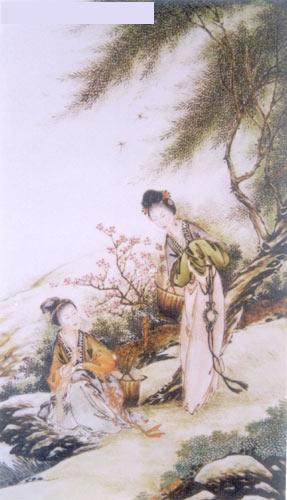
汪野亭 Wangyeting (1884-1942)
汪Wang entered the the Jiangxi Ceramics institute in 1906, where he studied under 潘淘宇Pantaoyu. He first specialized in nature scenes but later moved to landscapes and established the pastel green landscape technique. The compositions of his paintings mimic the masters known as the four kings of the early Qing dynasty, 王时敏Wangshimin, 王鉴Wangjian, 王翚Wanghui, and 王原祁Wangyuanqi. His work is characterized by its hearty brushwork and lustrous colors. His studio was known as 平山草堂pingshancaotang.
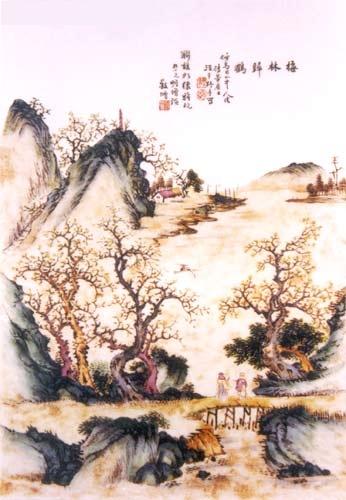
程意亭 Chengyiting (1895-1948)
程Cheng's pseudonyms were 佩古齋Peiguzhai and 翥山樵子Zhushanqiaozi. He entered the Jiangxi Ceramics institute in Poyang in 1911, where he studied painting under 张暁耕Zhangxiaogeng and 潘勾宇Pangouyu. He later became a disciple of painter 程瑶生Chengyaosheng of the Shanghai Zhe school. He specialized in nature paintings. His compositions are unique and mix realism and exaggeration. He expresses the feel of bird feathers with exquisite brushwork. His painting style falls between that of 蒋南沙Jiangnansha and 恽南田Yunnantian.
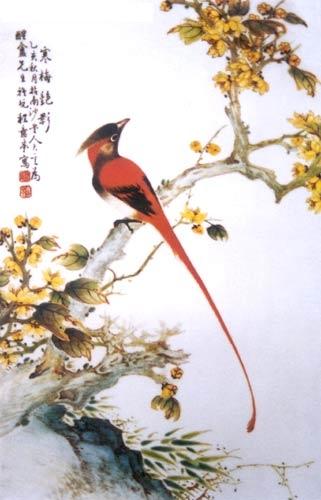
劉雨岑 Liuyucen (1904-1969)
劉Liu's pseudonyms were 澹湖渔Danhuyu and 六旬后号巧翁Liuxunhouhaoqiaoweng. in 1918, he entered the Jiangxi Provincial Jiazhong engineering and Ceramics School, where he studied painting under 潘勾宇Pangouyu. after marrying 朱秋霞Zhuqiuxia, daughter of Jingdezhen ceramicist 朱受之Zhushouzhi, he specialized in paintings of flora and fauna. He later became the adopted son of the great Jingdezhen ceramics painter 王琦Wangqi and worked with him in establishing the Porcelain arts Research institute and the 月園会Yueyuan Society.
in the Republic era, 劉雨岑Liuyucen worked as an instructor at the Fuliang County Pottery School, the Zhushan National Technical School for the Porcelain arts, and the Dongfang Technical School for the arts. His early style was extremely delicate. During and after his middle period, he painted nature scenes by studying one of the techniques in oriental painting 没骨 mei gu (where gradients are expressed in ink and pigment without using outlines) of painters such as 恽南田Yunnantian and 任伯年Renbonian. 劉雨岑Liuyucen's greatest achievement is surely his invention of the "water point" painting technique. The development of this technique allowed the so-called freehand style of Chinese painting to be worked into porcelain art. Works of his are kept in The Palace Museum.
in 1975, 劉雨Lliuyucen's son, 劉平Liuping, developed an improved version of the technique his father had invented, known as the "water point peach blossom" technique, and directed the designs for the Number 7501 中南海Zhongnanhai Porcelains, which are known as People's Republic guan ware.
When using the water point technique, it becomes possible to create soft, blurry, watercolor-like lines, even with pastels, and to create a light, bright pink color. Peach blossoms drawn using this pink color are known as "water point peach blossoms".
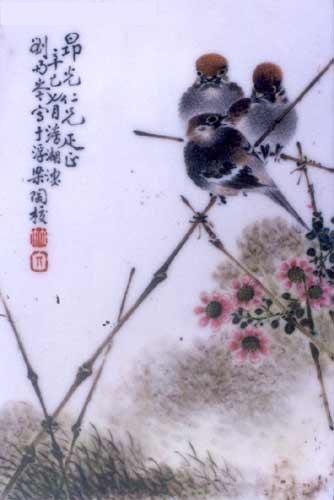
徐仲南 Xuzhongnan (1872-1952)
徐Xu's pseudonyms were 竹里老人Zhulilaoren and 江西南昌人Jiangxinanchangren. in his youth, he studied porcelain painting at a Nanchang porcelain shop, and in 1918 he joined the Nanchang Ceramics Corporation where he worked as Manager of Porcelain arts. He excelled at decorating with pastels. He specialized in landscapes and had a particular touch for plant imagery. a member of the 月園会Yueyuan Society, his studio was known as 棲碧山館Qibishanguan.
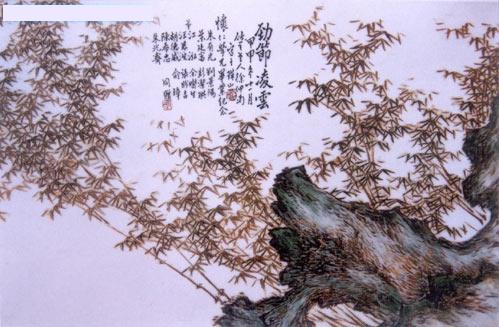
毕伯涛 Bibotao (1885-1961)
毕Bi's pseudonym was 黄山樵子Huangshanqiaozi. He studied painting under the artist 张雲山Zhangyunshan.
in the early years of the Republic, he began work in porcelain painting after moving to Jingdezhen to make a living and joining the 月園会Yueyuan Society at the invitation of 王琦Wangqi and 王大凡Wangdafan.
毕伯涛Bibotao focused on painting flower vases and tea trays. He painted birds such as crested mynas, mandarin ducks, and indian paradise flycatchers. although the only three colors he used were green, yellow, and black, his work is refined. His style falls within the 新羅山人xinluoshanren school. at the time he was not popular, and his works are extremely few.
Many of his students grew to become modern Jingdezhen ceramics artists, and among them his son 毕渊明Biyuanming is a representative figure of this period of Jingdezhen.

田鶴仙 Tianhexian (1894-1952)
田Tian's pseudonyms were 梅华主人Meihuazhuren and 荒园老梅Huangyuanlaomei. His studio was known as 古石斋Gushizhai. in the early years of the Republic, the nearly middle-aged 田Tian began work in porcelain painting after an encounter with the Jingdezhen porcelain painting master 徐仲南Xuzhongnan. in his early period, he specialized in landscapes. His style changed markedly after he became a member of the late 月園会Yueyuan Society as he studied the plum portraits (images with plum trees as the subject) of the yuan dynasty artist 王冕Wangmian and took the lead in painting plum portraits on porcelain ware. His paintings of plum trees exerted a major influence on the course of modern Jingdezhen porcelain decoration.
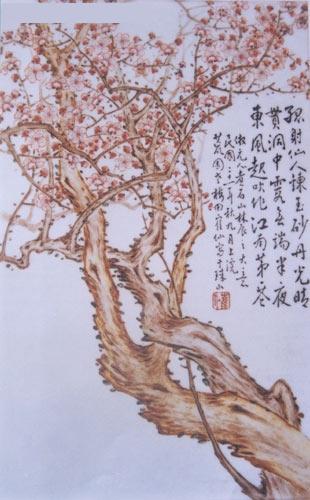
鄧碧珊 Dengbishan (1874-1930)
鄧Deng's pseudonyms were 铁肩子Tiejianzi and 江西余干人Jiangxiyuganren. a porcelain painter who excelled at underwater scenery, the influence of Japanese art can be seen in his paintings. His literary illustrations 詩書画印 (a traditional Chinese art form where a single subject is expressed through writing, ink wash images, and seal engraving) are also exceptional. a central figure in Jingdezhen.
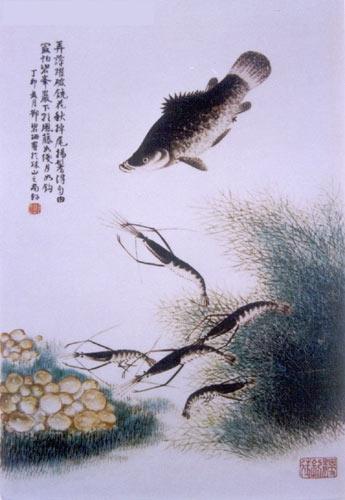
State-owned porcelain factories
In the 1900s, as mass production and mechanization of the ceramics industry were progressing in the West due to the industrial revolution, China also modernized Jingdezhen and developed coal kilns. After that, most of the porcelain produced in the state-owned porcelain factories was fired in coal kilns, and a part was fired in firewood kilns that were fueled by pine tree wood. However, in the 1990s, these manufacturing methods came to be considered bad for the environment, and they were replaced by the eco-friendly, energy-saving gas kilns and electric kilns. Ceramics fired in coal kilns and firewood kilns back then have a distinctly different appeal compared to those fired in modern kilns. Coal kilns gradually reduced operations from the end of the 1950s and were completely shut down in the 1990s. Therefore, the production period at the coal kilns is limited, and the porcelain produced at that time cannot be replicated and has great value. Currently, Jingdezhen is designated by the state as one of the resource-depleted cities, and the state-owned porcelain factories have been gradually reorganized and dismantled in the process of transition from planned economy to market economy in the 1990s. Porcelain manufactured at the state-owned porcelain factories is attracting attention from many collectors, and its price is rising year by year. Some of the finest items were sold at auctions by major companies at a price of more than CN¥1 million.
Note: 江西瓷業公司 Jiangxi Porcelain Company (1907-12), one of the state-owned porcelain factories, succeeded in setting up a coal kiln, but it was never allowed to use it because its chimney was very close to the police station, so porcelain was manufactured in a wood kiln fueled by pine trees. Therefore, the porcelain of Jiangxi Porcelain Company is considered to have rarity value.
The ten porcelain factories
After World War II, People's Republic of China was established in 1949. The government built over 10 state-owned porcelain factories to revival Jingdezhen.
The factories are as known as 十大瓷厂 (the ten porcelain factories).
红旗瓷厂Hongqi porcelain factory (ex. for Zhongnanhai, a residential district for government leader, politicians and VIPs)
宇宙瓷厂 Yuzhou porcelain factory (ex. for export, dinner ware for domestic use)
東風瓷厂 Dongfeng porcelain factory (ex. traditional porcelain, for political leader)
红星瓷厂 Hongxing porcelain factory (ex. cup and saucer, for export)
曙光瓷厂 Shuguang porcelain factory (ex. for gardening)
光明瓷厂 Guangming porcelain factory (ex. watermarked porcelain)
艺术瓷厂 Yishu porcelain factory (ex. antique re-product for dairy use)
人民瓷厂 Renmin porcelain factory (ex. for dairy use)
建国瓷厂 Jianguo porcelain factory (ex. ancient re-product)
景兴瓷厂 Jingxing porcelain factory (ex. for wedding)
other factories,
为民瓷厂 Weimin porcelain factory (ex. for export)
華風瓷厂 Huafeng porcelain factory (ex. high-grade porcelain for gift, for dairy use)
紅光瓷厂 Hongguang porcelain factory (ex. high-grade table ware、for export)
新光瓷厂 Xinguang porcelain factory (ex. high-grade table ware、for export)
雕塑瓷厂 Diaosu porcelain factory (porcelain dolls)
Note: There are over 10 factories, however, Chinese call all of the state-owned porcelain factories in Jingdezhen in middle of 20C as 十大瓷厂 (the ten porcelain factories).
水点桃花 Water Point Peach Blossoms
in 1975, the Chinese Light industries Porcelain institute in Jingdezhen received instructions from the Central Guidance Ministry of Jiangxi province requesting the production of porcelain ware for 毛沢東Maozedong and ordering the creation of newly-designed porcelains to be used exclusively in 中南海Zhongnanhai (the location of the Central Guidance Ministry).
This project, as the most important of 1975, was dubbed "operation 7501" (with operation meaning Project in Chinese).
40 top class artisans of Jingdezhen applied their utmost skills for 毛沢東Maozedong, and the resulting 1000 items were sent to Beijing.
it is said that 毛沢東Maozedong particularly liked the stationery, smoking implements, tea ware, and dining ware, which were painted with red plum blossoms.
at present, the "毛沢東Maozedong's favorite peach and red plum blossom ware" made in this period have come to be called "water point peach blossoms".
